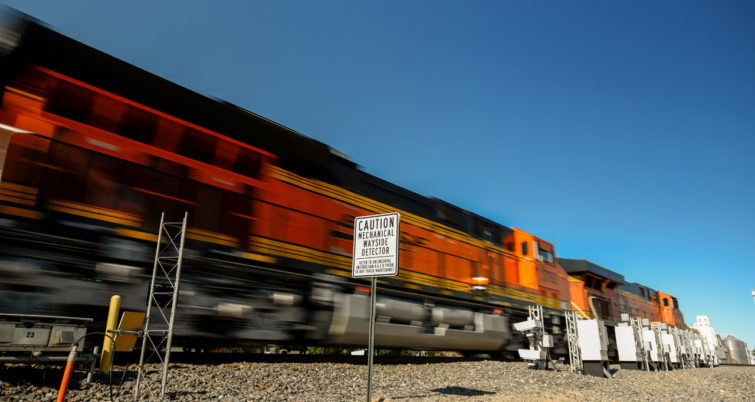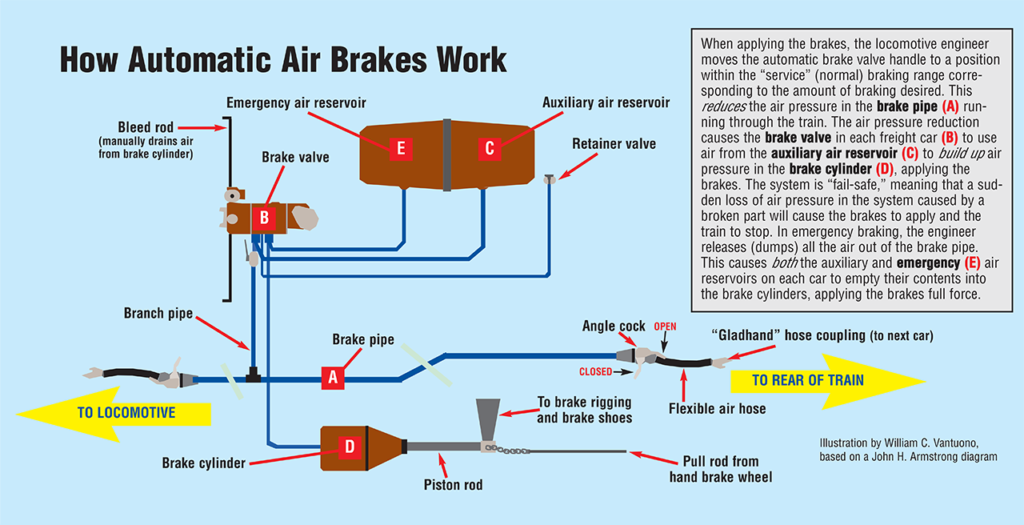Possible Paths to New-Tech Safety Improvements
Written by Jim Blaze and Crew Heimer
Crew Heimer joins Railway Age Contributing Editor Jim Blaze to look at what improvements can be done with respect to train derailments like that in East Palestine, Ohio. They suggest a better-quality use of the data already being collected followed by other improvements in the predictive fault capabilities of modern technology. A long-term demonstration of improved ECP (electronically controlled pneumatic) brakes to replace existing air brake technology might also be attempted. But beware: All this might take three to four years of design and robust testing, just to prove the business case. After that, full implementation to ECP brakes will need a much longer time.
From accidents eventually comes improvement. We all wish to reduce the number of railcars derailed in future incidents, as well as the severity of a derailment. The “how to get it done” might take a bit of R&D time.
Some things might be accomplished faster. What is an optimum safety improvement? Let’s explore that.
One opportunity is better use of the huge databases already collected and then electronically warehoused (stored). How could we do that? Start with the fact that most hot bearing detector (HBD) locations are independent silos of collected data. In most applications, they do not share data or intelligence with one another. If one HBD detects a car in a reportable defect state, an alert is transmitted to the train crew, but not to the other detectors along the train’s route. The data is more likely sent to a central back-office collection and processing location.
An improved approach involves comparing previous silo-recorded readings and finding/tracking the higher-temperature-changing railcar car outliers before they reach dangerous temperature thresholds. The captured HBD field data would be filtered in near-real time by an algorithm that then sends a live alert message to the train crew and to the dispatching center/trouble desk when a railcar’s journey through the network shows a pattern of a predictable future time and possible failure location. The idea is to stop a train as soon as a car with an increasing sign of failure is identified. This approach would also apply to other types of fault detectors (dragging equipment, wheel impact load detectors, etc.). The key would be to integrate all this data and make it available in real time or near-real time.
How much data is already available for better intelligence? How much are we talking about? As an example, BNSF’s track network detectors (HBD and others) collect and process (organize) more than 35 million readings every day taken from some 4,000 wayside sensors. BNSF began its use of machine vision systems (MVS) with its network of wayside detectors to reduce rail equipment incidents and service interruptions, John Martin, Director, Technology Services, told Railway Age in 2020. Specifically, the railroad’s mechanical experts and data scientists sought to spot trends with the urgency of equipment repairs to indicate when maintenance should occur. The technology works, explained Martin, by using artificial intelligence (AI) in combination with MVS to analyze equipment images and identify small defects before they lead to larger problems, such as equipment failure.
“Today’s AI models have advanced with increases in computer processing capabilities,” Martin said. “With these advances, we have integrated BNSF’s Mechanical Image Driven Analytics System (MIDAS) with an equipment monitoring quality system that allows us to easily cross-reference MVS information with other data from our network of 4,000 sensors that monitor rolling stock across the BNSF network.”
BNSF is not the only railroad to utilize this type of technology. However, such systems are not yet universally deployed throughout the entire North American network. As one of our field-experienced rail colleagues reminds us, “We don’t need better data. We need to take the existing data points and used them as actionable intelligence. We need to sort data immediately and continually to create an actionable outlier pattern that reflects a changing condition (like temperature) from detector to detector to predict a failure condition as the train moves down the tracks.”
Everybody wants more locations and more data. But first, what are we doing now with the mass of data—“Big Data”—we already possess? Perhaps far too little in the mechanical problem area. Predictive analytics is a standard civil engineering tool set in the rail industry. We use it to measure life cycle and replacement of rail, ties, ballast, etc. The industry needs to rapidly move ahead on the mechanical side, building upon current efforts by railroads and suppliers.
Braking, Fact vs. Fiction
Contrary to the bogus characterization being spread in the general news media (and even by a former Federal Railroad Administrator in 2016) calling air brakes “19th Century” or “Civil War era” technology, modern pneumatic braking is in truth a refined system that has been continuously improved since George Westinghouse patented his fail-safe technology, which uses compressed air, in 1869. (Westinghouse that year presented his invention to Railway Age.) It has served the rail industry well for generations. Its principal North American suppliers, Wabtec and New York Air Brake, working with the railroads and car and locomotive builders, can reasonably claim that their systems are state-of-the-art.
The basic principle remains the same as that invented by Westinghouse, now an enhanced system to transmit a “stop instruction” at about 900 feet per second along the train’s length, depending somewhat upon ambient temperature:

The air movement activation process might take three-four seconds on a long train before full braking activates along the entire length of the train from the lead locomotive. At 50 mph, this may mean an extra four railcars (240 feet of length) are possibly pushed into a pileup at the derailment point. Think of the physical striking (buff) force as cars run into one another.
These effects can be mitigated by a simultaneous brake application coming from the rear of the train by a two-way EOT (end of train) device (required since 1996). As well, in longer consists with DP (Distributed Power), the brakes are set at remote locomotives simultaneously with the command initiated on the lead locomotive, providing a more uniform air brake response throughout the train. Dynamic braking further improves stopping response.
Norfolk Southern general merchandise train 32N, the one that derailed in East Palestine, had one DP unit in the consist and was using dynamic braking at the time of the accident.
“ECP technology is nothing new,” Railway Age Editor-in-Chief William C. Vantuono wrote in a 2016 editorial. “It’s merely a different method—an electronic method—of transmitting the brake activation signal from the locomotive to each railcar. ECP uses a hard-wired electronic train line to do that, instead of the train’s brake pipe. But, it still uses air brakes, with air reservoirs and valves and brake cylinders, brake beams and brake shoes. It still needs a brake pipe.
”ECP systems and conventional pneumatic systems both have George Westinghouse to thank for inventing and patenting fail-safe air brakes. Today’s air brakes are high-tech, as there have been major advances in technology since George Westinghouse’s days. New York Air Brake’s BCM (Brake Cylinder Maintainer) is just one of the more-recent advancements.
”The difference in time it takes for a 100-car train with an ECP system vs. a conventional system with two-way EOT activation (required since 1996) and DP to trigger the brakes on all railcars is only about two seconds less for ECP. Once the brakes are applied, there is little or no difference between an ECP and a conventional system. The ECP brake system will not prevent a derailment caused by a journal burn-off, broken wheel or axle or a broken rail.
While that’s true, if railroads want to grow and capture truck market share, they will need a longer-term safety improvement strategy. Does one exist? Truck braking systems are getting better. What is the rail industry’s competitive response?
In addition to accelerating predictive analytics, we suggest that ECP braking needs to be revisited. Some type of improved system needs to be developed and fully tested in a real-world R&D service environment. This is an opportunity for railroads, carbuilders, component suppliers, car owners/lessors, the FRA, NTSB, Transport Canada and Canada’s Transportation Safety Board to collaborate and find out what the risk envelope is between “conventional” air brakes and possible upgraded ECP brake technology.
A business safety case is needed. Let’s do a new, rigorous, independent full cost-benefits study. Let’s use the results to decide on a possible commercial implementation approach. Share that R&D intel with railroad customers. After all, more than half of the nation’s freight cars are owned or leased by shippers, receivers, or third-party leasing companies. They would have legal “skin” in a strategic outlook risk management assessment. Most important, let’s be proactive and do this before we’re regulated into it through an Act of Congress and an unfunded mandate.
That scale of braking system change would likely take the better part of one to two decades. Capital cost? Unknown.
Crew Heimer is a career railroader with a history at CSX and more recently with Intellectual Concepts. LLC—a boot on the ground-type of engineer that thinks like an economist. Jim Blaze is a former Conrail and state/federal rail economist (and longer-term contributing editor to Railway Age) who learned under Dr. Allan Zarembski at Zeta-Tech Associates to think like an engineer. Their joint remarks reflect their own opinions, and offer independent thinking to readers.
Railway Age Editor-in-Chief William C. Vantuono contributed to this editorial.





